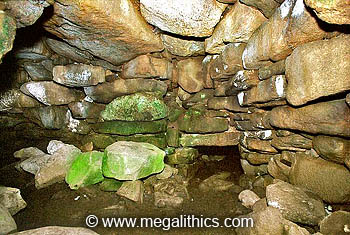
 |
|
Photo Gallery |
|
|
VR Tour |
|
| SW 38372 35541 (GPS 20min) entrance. | |
| Visited August 2001 |
The Pendeen Fogou is situated in Pendeen Manor
Farm close to Pendeen Manor House. William Borlase, one of the
earilest scholars of Cornish prehistory, was born in the Manor in 1693, and we like to think of the Pendeen Fogou as "his" Fogou. We wondered if the close proximity to
this antiquity in his early years may have kindled his interest in prehistory.
"Fogou" is the name given to certain underground chambers and passages found in Cornwall, they
are about 2000 years old, dating from the Iron Age. The word fogou is dervied from the Cornish for "cave", in Scotland similar structures are known as "Earth Houses" and the generic term for underground structures such as these is "Souterrain". The original purpose of fogous is unknown, there are various theories involving food storage or defensive refuges, but after visiting several of the more intact
examples that survive today, we have to say that we don't think that either of the these suggestions are
realistic.
The modern entrance to the Pendeen Fogou is in an earth backed stone wall, the original entrance point is unknown, but if it was similar to those we have seen in other fogous, it would have been a tightly constrained "creepway". The first part of the
Pendeen Fogou is a passage that runs straight for about 7m due north, and slopes downwards quite steeply. The roofing lintels are stepped like the underside of a staircase to accommodate the fall. At the bottom of slope the passage turns about 45 degrees to the left (northwest),
and continues for a further straight fairly level run of about 10m. At the end of the northwest section there is a small opening to the outside, which is very small and irregular. It looked to us as if the stonework around this opening was quite
severely disturbed, and we could not tell if this had been an original opening or a modern penetration or truncation.
The northwest passage displays a typical fogou structure, stone walling slopes gradually inwards with height to be capped by stone lintels, forming a characteristic trapezoidal cross-section. The complex roof work at the "corner" where the passage turns is particularly impressive, especially considering it has survived intact for so long. The floor of the main passage is strewn with many largish stones and we wondered where these had come from, as the walls seemed very intact.
At the apex of the bend in the main passage there is a lintelled opening about 50cm high, set low in the north wall, this leads to a chamber running off northeast. This chamber is not of typical fogou construction, being a simple void hollowed out of the Rab. "Rab" is a conglomeration of granite particles bound together with clay, a sub-soil which is found commonly in Cornwall.
The chamber has a semicircular cross-section and is about 1.25m high in the centre, it runs for about 7.5m and is about 1.75m wide at floor level. The back of the main fogou passage sidewall is visible from inside the rab-cut chamber. We noticed that the rab sidewalls
did not meet the stone work cleanly, as though the wall had been built across an existing
opening.
The floor of the rab chamber was mostly ankle deep mud during our visit and there was a small pool at the
very end of this chamber, the main fogou passage also had many pools of standing water. A "tidemark" stain about 50cm above floor level ran around the walls of the rab chamber, showing perhaps, just how wet this fogou can get.
As with many ancient places, the fogou has several stories and legends associated with it. One tells of how before part of the roof fell in, the passage ran all the way to the sea. Another extends the length of the passage even further, all the way under the sea to the Scilly Isles. Of course, no ancient underground chamber would be complete without a ghost, and the Pendeen Fogou is no exception. All versions of the legend agree that the spirit of the fogou is a tall woman in white who appears at the entrance to the fogou. Some accounts add a red rose held in her mouth, and some say that she only appears on Christmas morning. One firm area of agreement is that an encounter with the Lady in White is not desirable, some accounts say that all who see her will die within a year, others that those who follow her into the fogou will see her change into a terrifying
and deadly form once inside her domain.
We did not see the Lady in any of her forms during our visit, and we're always in our element crawling around in pitch dark ancient passages and tombs, but we have to say that we found the atmosphere in the rab chamber a little uncomfortable. We later found that all of the spherical panoramas that we took at the end of the chamber were fogged, but only where they faced the end wall. You can see this as a kind of dark cloud in the terminal
panorama, this is probably due to a complex reflection path involving the pool
of water and the curved shape of the tunnel end
.............. probably.